Brief

At a Glance
- The European used car market will continue to grow, despite the coming recession.
- The main market driver will be low availability of young cars in the face of continuing global supply chain disruptions.
- The often-discussed impact of battery-electric vehicles on the used car market will be positive rather than negative.
- While new online business models will disrupt the market, it will be largely at the expense of consumer-to-consumer transactions and less at the expense of traditional dealers.
For many years, the European used car market has been a large and attractive market with healthy growth. Current Bain market modeling indicates that key drivers are generally intact, and the used car market is expected to weather the coming recession well. While there may be turbulence in new car sales, the market for used cars is expected to remain more resilient and attractive for key players like car dealers, omnichannel players, automotive manufacturers, marketplaces, and investors.
High overall market attractiveness, despite the looming downturn
With a total volume of 429 billion euros in 2021, the market for used cars in Europe is similar to the market for new cars. Of the 32 million used cars sold in Europe in 2021, some 44% were sold privately in consumer-to-consumer (C2C) transactions, while 56% were sold by professional retailers, which tend to focus on higher-class, younger cars. Furthermore, used car margins typically beat new car margins for dealers. Overall, the used car market is growing healthily, with a CAGR of 7% between 2015 and 2021.
So far, Europe’s car retailers are still highly fragmented, and most firms operate only in very confined local markets: Together, Europe’s top 20 car dealerships trade only around 6% of all used cars.
The used car market is generally quite stable, even in downturns: Many people rely on their cars to reach work and see family, and they would rather sacrifice other purchases than give up their cars. In addition, new car buyers may switch to used cars when their older cars cannot be maintained economically and they can no longer afford new cars—so there will always be turnover in the used car market. Therefore, even though the economic environment is expected to become more difficult in the coming years, Bain expects the used car market to be more stable than other markets.
Bain & Company has comprehensively modeled the future European used car market, based on the probable influence of the most relevant market drivers, which were explored and tested through quantitative modeling and validated in structured expert interviews. On this basis, Bain predicts a European used car market that will soon be back on its old 5% growth trajectory in the coming years (see Figure 1). Used cars are expected to enjoy stable turnovers for years to come, mainly due to almost four years of low new car production volumes from 2020 through 2023.
The EU used car market will return to 5% growth trajectory

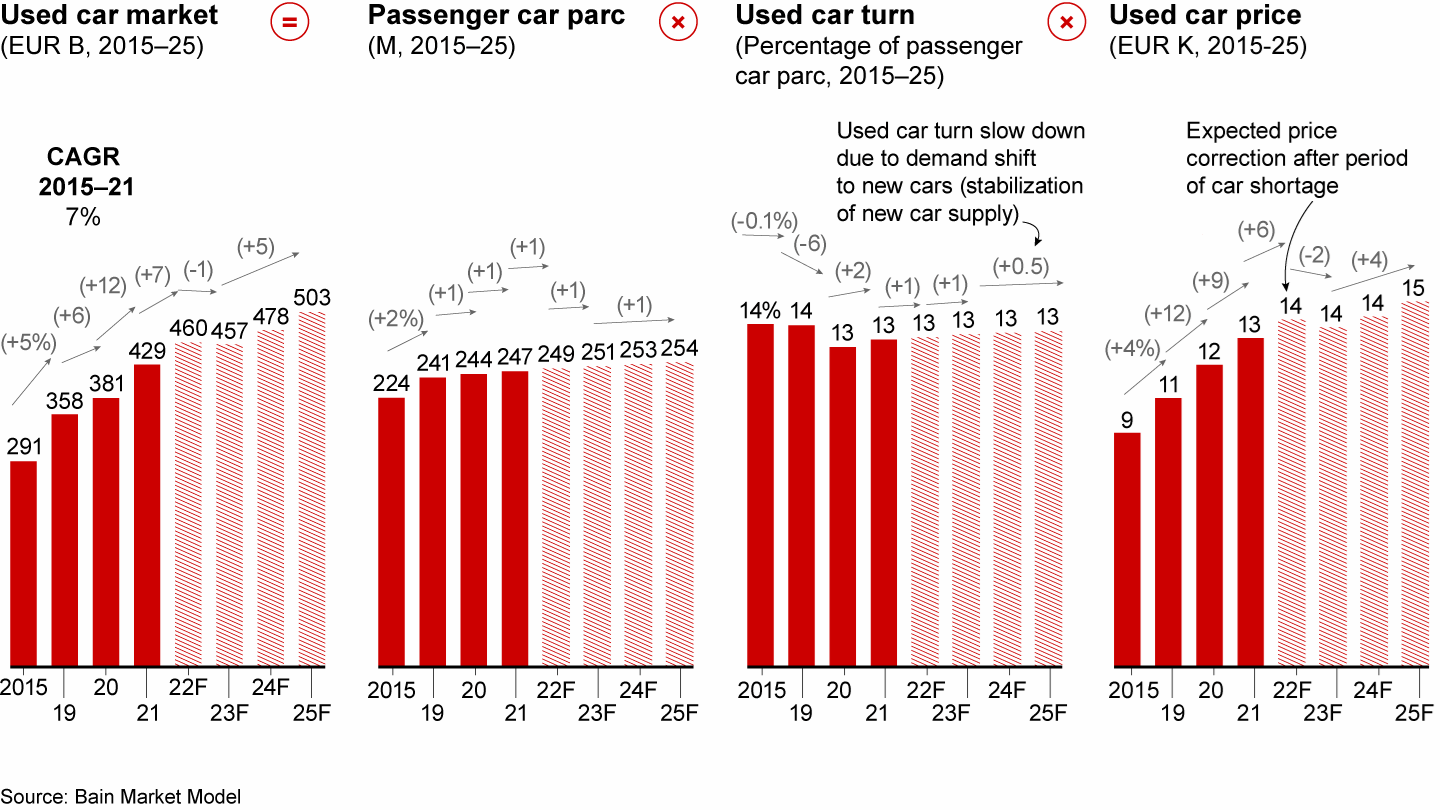
A structural undersupply of cars
The most significant market driver for used car sales will be the low availability of new and young used cars. Starting with disruptions caused by new Worldwide Harmonised Light Vehicles Test Procedure (WLTP) emission standards, followed by pandemic shutdowns and the semiconductor and shipping crises in their wake, European new car production and sales have taken a severe hit. The shortage in chips is expected to impact production of light vehicles at least until mid-2023, but with further shutdowns in China still possible and the war in Ukraine leading to shortages in raw materials and parts, such as wiring harnesses for German automobiles and soot for tire production, further disruptions are foreseen. By that point, cumulative production will be at more than 10 million units behind the pre-shortage expectations. In the longer run, electric vehicle production is also likely to face repeated battery shortages. This would limit European electric vehicle output, which, because of existing European fleet emission standards, could not be balanced by production increases for cars with internal combustion engines. Thus, further shortages are highly likely in the near future.
Fewer new cars produced and sold means there is a lower supply of young used cars, as more customers who cannot get their preferred new cars are thus going for younger used cars. There is also still a pandemic backlog in the demand for cars—many people in Europe have postponed their car purchases during the shutdowns. Taken together, these developments mean there is a structural undersupply of cars in Europe that is expected to keep up prices for new and especially used cars, even in a downturn. We already saw used car prices surge 9% to 12% between 2019 and 2021. Despite lower demand during the first half of 2022, residual values of used cars have continued to go up faster than the list prices for new cars (see Figure 2).
Different market drivers are at play in the European used car market

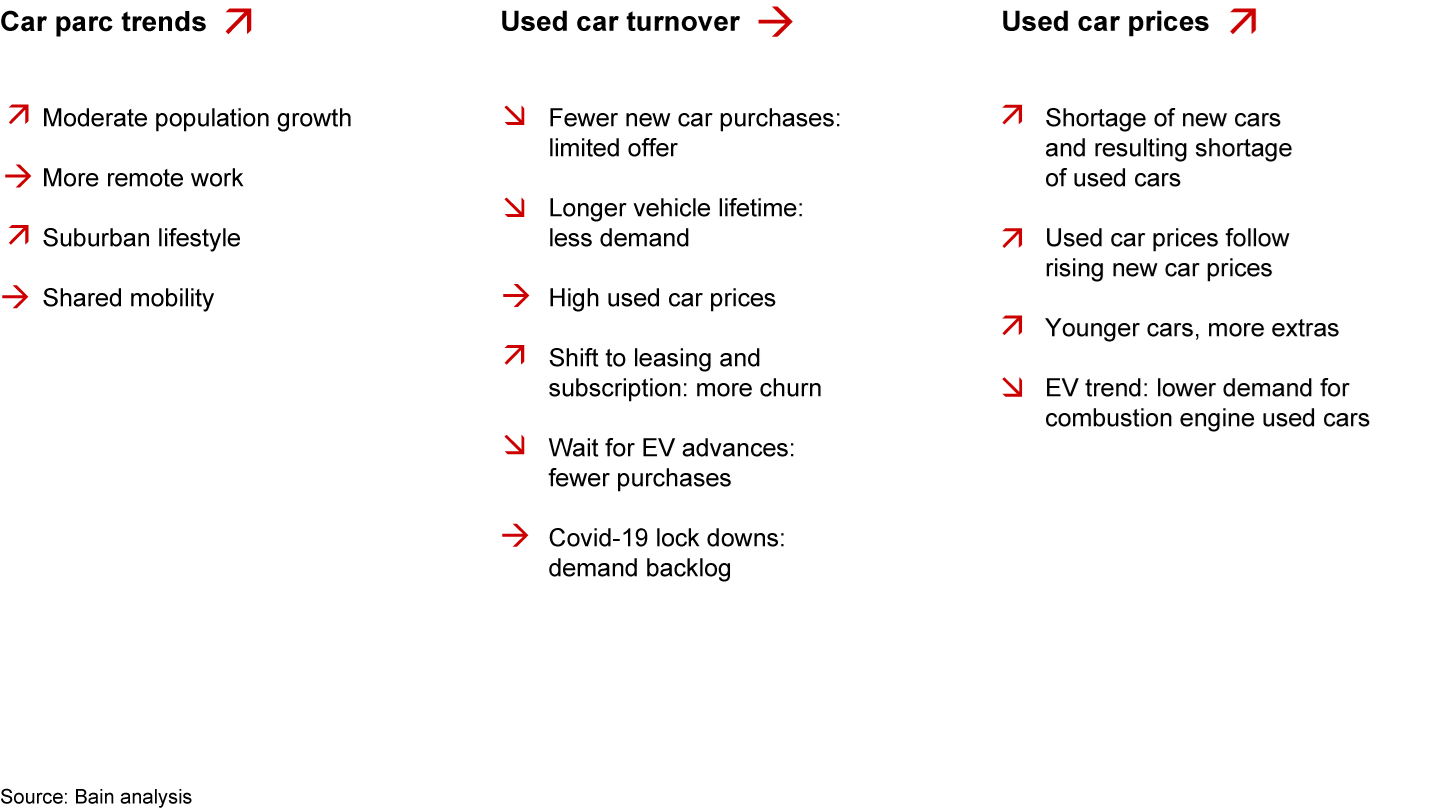
Battery electric vehicles help the used car players
Pushed by the EU and a growing awareness for sustainability, there is a strong shift to battery-electric vehicles (BEVs) in Europe. In 2021, Europe became the second-largest BEV market after China, with sales of 1.2 million BEVs, a 63% rise compared with 2020 (see Figure 3). Three questions are especially important when assessing BEVs’ impact on the used car market: Will BEVs change the frequency of vehicle sales? How stable will the residual values be? How will used BEVs be traded in the future?
Just four countries make up majority of European used car market

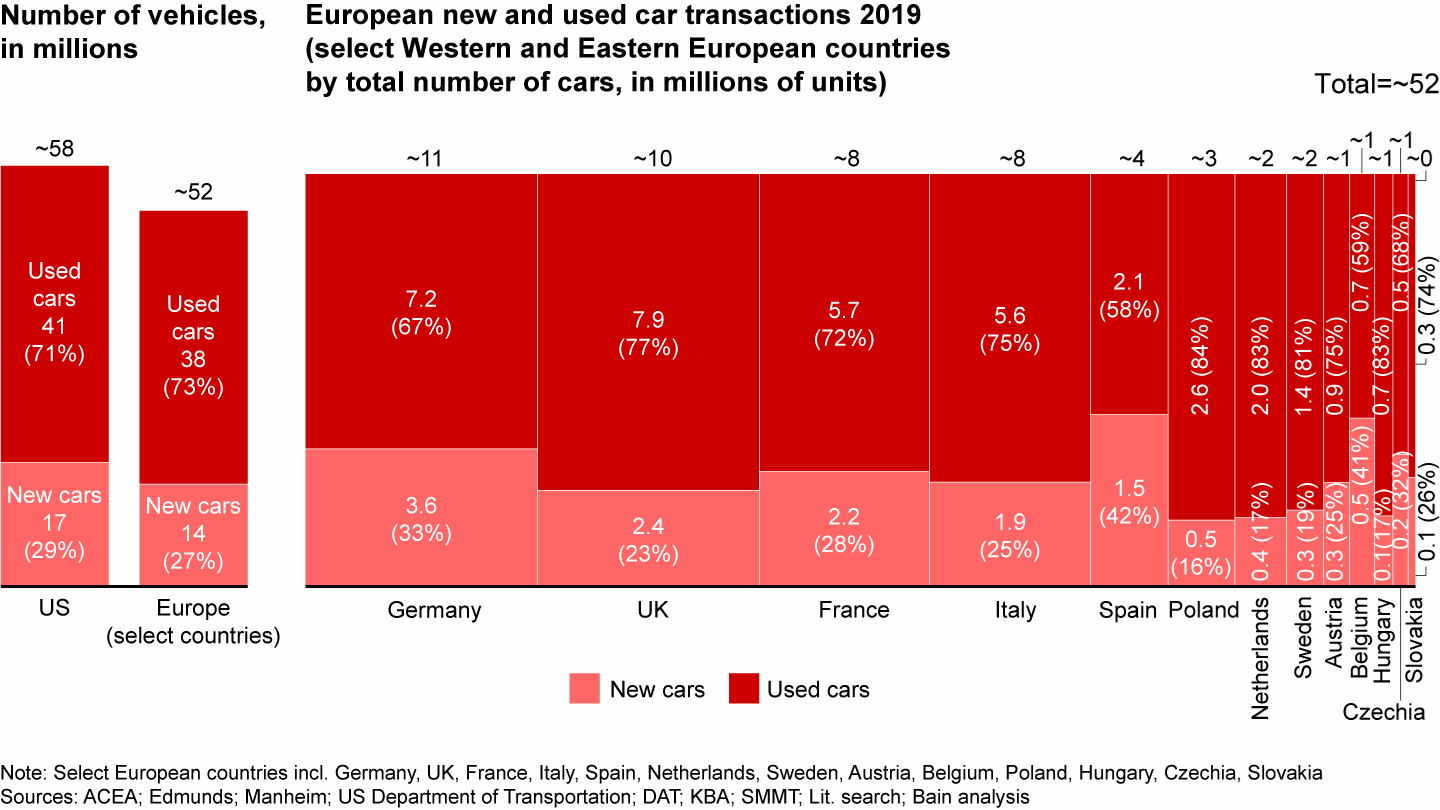
So far, BEVs have meant faster turnover for the used car business. Early BEV adoption markets like Norway show a clear increase in used car sales activities: Some car owners change to a BEV before the date when they would normally have bought a new car. Also, initial BEV customers replace their cars more frequently, as new and technologically advanced BEVs come out (offering, for example, faster charging, bidirectional charging, or newer battery technologies). This outweighs the smaller opposing effect of owners of traditional cars holding on longer to their combustion engine cars, waiting for BEVs to become more mature and affordable. Early-BEV-adoption countries have thus experienced a slight overall price increase in used cars, as more expensive BEVs and younger used cars have come on the market.
The residual value of used BEVs is generally higher than that of comparable combustion engine cars because of their higher new car price, further supporting high price levels on the used car market. The price for an individual BEV will largely depend on the state of the battery, which is the most valuable and degradable part of the car. Thus, most buyers prefer services like professional battery status checks and battery warranties. This favors business-to-consumer (B2C) sales over C2C sales and should thus benefit the dealerships.
Additionally, the higher cost of BEVs means more need for used car financing, leasing, or more innovative arrangements like used car subscriptions—further opening new opportunities for dealers, especially over peer-to-peer transactions. Further, BEVs create new customer needs for accessories like charging cables and home charging stations (wallboxes), which dealers can readily supply—maybe even including installation services. In addition, BEV drivers have a higher affinity to online channels, possibly leading to a preference of dealers with professional online channels.
New online business models to buy and sell
Over the past several decades, the commercial used car market has remained largely traditional, centered on local dealerships. The 1990s and first decade of the 2000s brought traditional offline classifieds online, in the form of websites like Germany’s mobile.de and France’s Leboncoin. Only lately, such sites have started offering additional services, like direct online car buying and subscriptions. It took until the late 2010s for true digital retailers to appear: Companies like Autohero, Carvago, and Driverama offer a full digital sales experience—including a virtual “seat trial,” free delivery, full vehicle checks, warranties, and a host of optional extra services and guarantees.
Alongside online sales platforms, there are also online acquisition platforms that buy used cars from consumers and commercial sellers alike. They use asset-heavy business models, like Wirkaufendeinauto (Germany), or asset-light models, like Motorway (UK). After some problems in the beginning, these online purchasers now transparently and reliably offer fair market prices with considerably less hassle, according to independent market checks.
Initially, investors hyped used car online retailers. AUTO1, the publicly listed company behind Autohero and Wirkaufendeinauto, raised 1.8 billion euros when going public in February 2021 and was hailed as one of Europe’s unicorns. But the hype was short lived, and in light of Europe’s slide into stagflation as a result of the war in Ukraine, AUTO1 lost more than 80% of its stock value by December 2022. Two other online used car retailers decided to leave the German market altogether: Cazoo and Carnext, focusing on their core markets again.
Despite this temporary setback, Bain & Company’s scenario modeling shows that there might be substance beyond the hype. Online used car retailers are still poised for growth: In 2020, online sales of used cars were around 1% in Europe. The Bain market model predicts that the European used car market will continue to professionalize and move online (see Figure 4).
European used car market continues to move online

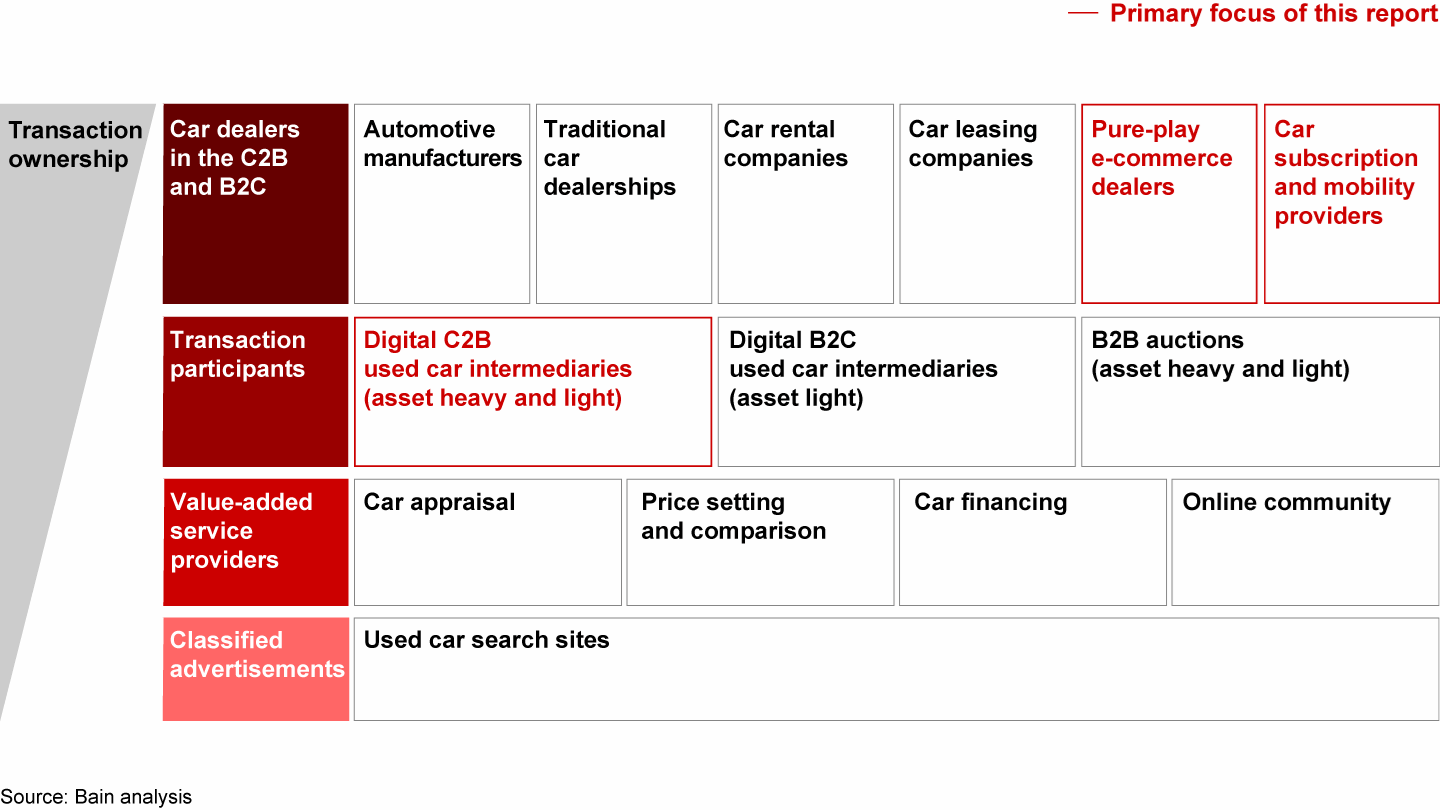
Online is all about convenience and trust
Online car sales’ clear advantage lies in its convenience to the customer: The buyers do not have to physically hunt down, examine, and test-drive their future cars or fear being cheated in the transaction. Rather, the buyer can comfortably do everything from their living room couch. The main challenge of this sales channel lies in building trust: Are there hidden problems with the car? Will I receive the purchase in a safe way? This is where risk-mitigating services come into play: the brand’s strength and trust, expert opinions, extended warranties, special insurances, and local repair partners to fix minor issues.
To succeed in this market will require building excellence into all steps of the customer journey—including research, finding the right offer, examining the car, test drives, old car trade-in, price negotiation, contract closing, payment, and final car delivery. For a car dealership to move online, some of these steps must be either digitized or executed by local partners. Successful online traders will probably establish a hybrid model, featuring online conveniences as well as physical representations on the ground to generate trust; players like Cinch and Cazoo already do this.
As professional online dealers continue to remove customer pain points, there will be a significant market shift from C2C to C2B2C. The key to this development is transparent and hassle-free purchase and sales processes as well as risk-reducing services, like warranties, insurance, and maintenance plans.
Online will see solid growth in the future
Bain’s driver-based market model sees three scenarios for online players in the used car market: The first is a low-case scenario in which post-pandemic customers largely return to traditional car dealerships and no new competitors appear on the scene. Still, this would mean that 3% of all used cars will get sold online in 2025, adding up to 15 billion euros that year (see Figure 5). In the base-case scenario, we are seeing major online players developing and new business models emerging. This can draw more customers to online buying and would generate a 4% online share in 2025. The high-case scenario even predicts a market growth of the top online car dealerships along the median of other online retailers post-Covid. In this case, the online channels could gain a 6% share of the used car market, or a transaction value of 26 billion euros.
Online offers high growth perspectives in the European used car market

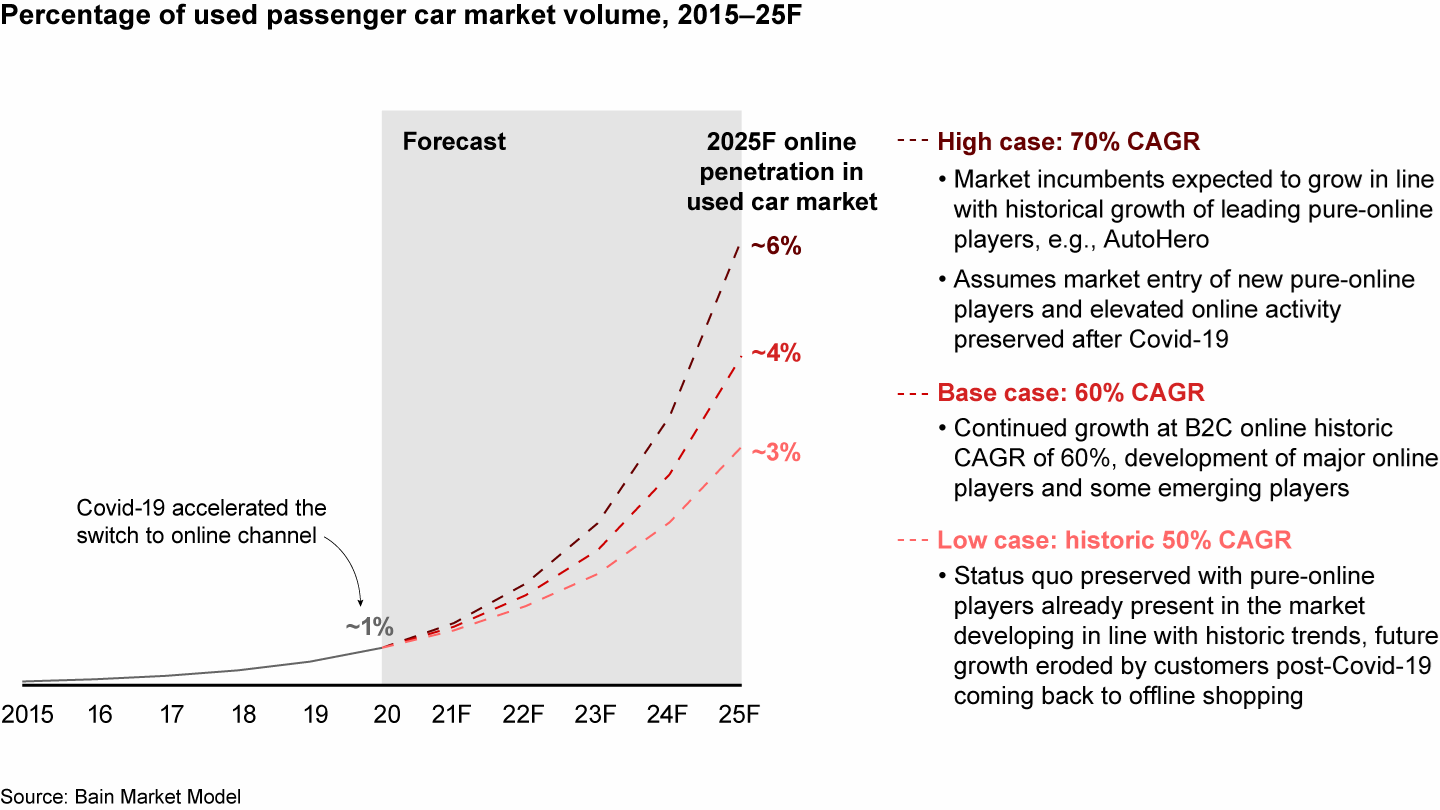
An attractive market with significant digital disruption
For the years to come, the used car market will remain an attractive business field for many different players. This includes traditional car dealers (franchised and independent), new omnichannel players, automotive manufacturers, online marketplaces, and investors, as well as new digital disruptors like B2B2C or B2C platforms. New emerging customer needs such as professional battery testing and an increase in existing needs for used car financing, leasing, and subscriptions further open opportunities for new digital business models.
Market participants should evaluate how the market shifts anticipated in this report will impact their businesses and how they can profit. Now is the time for all players to actively develop their business models. The aim should be to occupy a sweet spot within the changing used car environment that can ensure continued success in this highly interesting market.
The authors would like to acknowledge the contributions of Pawel Szreder to this report.